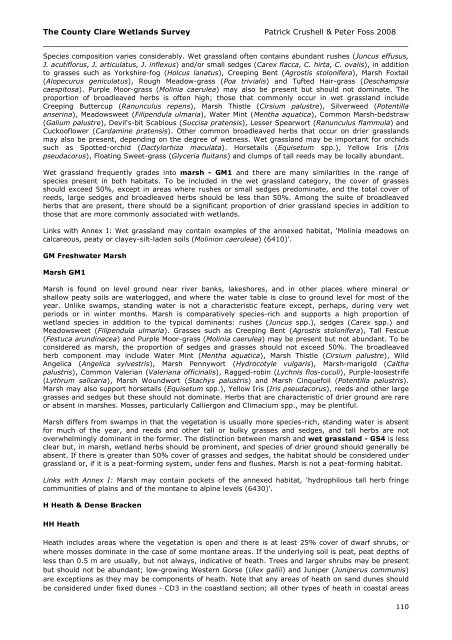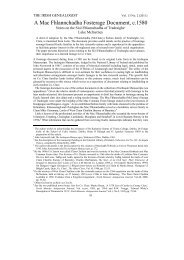Report Cover Vol I - Clare County Library
Report Cover Vol I - Clare County Library
Report Cover Vol I - Clare County Library
You also want an ePaper? Increase the reach of your titles
YUMPU automatically turns print PDFs into web optimized ePapers that Google loves.
The <strong>County</strong> <strong>Clare</strong> Wetlands Survey Patrick Crushell & Peter Foss 2008<br />
_______________________________________________________________<br />
Species composition varies considerably. Wet grassland often contains abundant rushes (Juncus effusus,<br />
J. acutiflorus, J. articulatus, J. inflexus) and/or small sedges (Carex flacca, C. hirta, C. ovalis), in addition<br />
to grasses such as Yorkshire-fog (Holcus lanatus), Creeping Bent (Agrostis stolonifera), Marsh Foxtail<br />
(Alopecurus geniculatus), Rough Meadow-grass (Poa trivialis) and Tufted Hair-grass (Deschampsia<br />
caespitosa). Purple Moor-grass (Molinia caerulea) may also be present but should not dominate. The<br />
proportion of broadleaved herbs is often high; those that commonly occur in wet grassland include<br />
Creeping Buttercup (Ranunculus repens), Marsh Thistle (Cirsium palustre), Silverweed (Potentilla<br />
anserina), Meadowsweet (Filipendula ulmaria), Water Mint (Mentha aquatica), Common Marsh-bedstraw<br />
(Galium palustre), Devil's-bit Scabious (Succisa pratensis), Lesser Spearwort (Ranunculus flammula) and<br />
Cuckooflower (Cardamine pratensis). Other common broadleaved herbs that occur on drier grasslands<br />
may also be present, depending on the degree of wetness. Wet grassland may be important for orchids<br />
such as Spotted-orchid (Dactylorhiza maculata). Horsetails (Equisetum spp.), Yellow Iris (Iris<br />
pseudacorus), Floating Sweet-grass (Glyceria fluitans) and clumps of tall reeds may be locally abundant.<br />
Wet grassland frequently grades into marsh - GM1 and there are many similarities in the range of<br />
species present in both habitats. To be included in the wet grassland category, the cover of grasses<br />
should exceed 50%, except in areas where rushes or small sedges predominate, and the total cover of<br />
reeds, large sedges and broadleaved herbs should be less than 50%. Among the suite of broadleaved<br />
herbs that are present, there should be a significant proportion of drier grassland species in addition to<br />
those that are more commonly associated with wetlands.<br />
Links with Annex I: Wet grassland may contain examples of the annexed habitat, 'Molinia meadows on<br />
calcareous, peaty or clayey-silt-laden soils (Molinion caeruleae) (6410)'.<br />
GM Freshwater Marsh<br />
Marsh GM1<br />
Marsh is found on level ground near river banks, lakeshores, and in other places where mineral or<br />
shallow peaty soils are waterlogged, and where the water table is close to ground level for most of the<br />
year. Unlike swamps, standing water is not a characteristic feature except, perhaps, during very wet<br />
periods or in winter months. Marsh is comparatively species-rich and supports a high proportion of<br />
wetland species in addition to the typical dominants: rushes (Juncus spp.), sedges (Carex spp.) and<br />
Meadowsweet (Filipendula ulmaria). Grasses such as Creeping Bent (Agrostis stolonifera), Tall Fescue<br />
(Festuca arundinacea) and Purple Moor-grass (Molinia caerulea) may be present but not abundant. To be<br />
considered as marsh, the proportion of sedges and grasses should not exceed 50%. The broadleaved<br />
herb component may include Water Mint (Mentha aquatica), Marsh Thistle (Cirsium palustre), Wild<br />
Angelica (Angelica sylvestris), Marsh Pennywort (Hydrocotyle vulgaris), Marsh-marigold (Caltha<br />
palustris), Common Valerian (Valeriana officinalis), Ragged-robin (Lychnis flos-cuculi), Purple-loosestrife<br />
(Lythrum salicaria), Marsh Woundwort (Stachys palustris) and Marsh Cinquefoil (Potentilla palustris).<br />
Marsh may also support horsetails (Equisetum spp.), Yellow Iris (Iris pseudacorus), reeds and other large<br />
grasses and sedges but these should not dominate. Herbs that are characteristic of drier ground are rare<br />
or absent in marshes. Mosses, particularly Calliergon and Climacium spp., may be plentiful.<br />
Marsh differs from swamps in that the vegetation is usually more species-rich, standing water is absent<br />
for much of the year, and reeds and other tall or bulky grasses and sedges, and tall herbs are not<br />
overwhelmingly dominant in the former. The distinction between marsh and wet grassland - GS4 is less<br />
clear but, in marsh, wetland herbs should be prominent, and species of drier ground should generally be<br />
absent. If there is greater than 50% cover of grasses and sedges, the habitat should be considered under<br />
grassland or, if it is a peat-forming system, under fens and flushes. Marsh is not a peat-forming habitat.<br />
Links with Annex I: Marsh may contain pockets of the annexed habitat, 'hydrophilous tall herb fringe<br />
communities of plains and of the montane to alpine levels (6430)'.<br />
H Heath & Dense Bracken<br />
HH Heath<br />
Heath includes areas where the vegetation is open and there is at least 25% cover of dwarf shrubs, or<br />
where mosses dominate in the case of some montane areas. If the underlying soil is peat, peat depths of<br />
less than 0.5 m are usually, but not always, indicative of heath. Trees and larger shrubs may be present<br />
but should not be abundant; low-growing Western Gorse (Ulex gallii) and Juniper (Juniperus communis)<br />
are exceptions as they may be components of heath. Note that any areas of heath on sand dunes should<br />
be considered under fixed dunes - CD3 in the coastland section; all other types of heath in coastal areas<br />
110
















